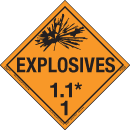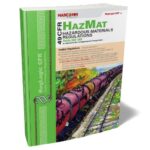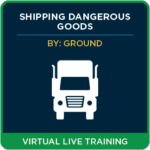
An Introduction: What You Need to Know About Shipping Class 1 Explosives
In The United States
Shipments of class 1 explosives in the United States are regulated by the Code of Federal Regulations (CFR). 49 CFR outlines specific guidelines and requirements that must be followed when shipping class 1 explosives, and it is essential to understand them.
In this blog, we will review the specifics of shipping class 1 explosives using 49 CFR.
Steps for Shipping Class 1 Explosives Using 49 CFR
- Apply for a license.
Before you can ship any type of explosive material, you must first obtain a license from the Bureau of Alcohol, Tobacco, Firearms and Explosives (ATF). This license is required for anyone who plans to manufacture, transport, or store explosives. https://www.atf.gov/explosives/apply-license
Remember to verify with your state – some states may have additional regulations that apply to shipments of class 1 explosives. Before shipping any explosive material, be sure to also check with your state’s Department of Homeland Security to make sure you’re following all applicable laws and regulations.
- Prepare the shipment.
Once you have obtained your license and verified with your state, it’s time to prepare your shipment for transit. This includes packaging it securely so that it won’t be damaged during transit, labeling the package correctly and ensuring that all required documentation is included with the shipment. Follow 49 CFR requirements – 49 CFR governs how hazardous materials should be transported in the United States. When shipping class 1 explosives using this code, there are specific rules that must be followed.
Acquire the proper shipping description that includes the UN Number, proper shipping name, and division of the explosive.
Let’s use for example: UN 0012, Cartridges, small arms, Class 1.4S,
- All package instructions are listed in 173.62 unless you meet any exceptions that would be listed in 173.63. In this case UN 0012 packaging instruction (PI) will be 130;
- All packages must be labeled correctly in accordance with 172.400. To be more precise for our example, an illustration is listed in 172.411;
- You must include an appropriate shipping document detailing all content requirements. This can be found in 172.201, but its important to note that under 172.202(a)(5)(i) the requirements of adding the net explosives quantity (NEQ) will be necessary. The NEQ is determined by taking into account the weight of the explosive material, any inert material that is added, and any packaging material that is used. Each shipment must be accompanied by an emergency response plan outlining how to respond in case of an accident. This can be accomplished by either attaching the safety data sheet of the product or noting the emergency response guide number to the shipping document;
- Finally, please note drivers transporting hazardous materials must have a valid Hazmat endorsement on their driver’s license, and remember vehicles used for transporting hazardous materials must meet certain safety standards.
Shipping class 1 explosives in the United States requires careful adherence to a set of detailed regulations outlined by 49 CFR—the Code of Federal Regulations governing transportation within U.S borders. These regulations cover everything from obtaining licenses and verifying state requirements to labeling packages correctly and providing emergency response plans in case something goes wrong during transit. Understanding these regulations is key when it comes time to ship class 1 explosives in accordance with federal law.
In Canada
The following blog will be a brief introduction to the regulatory requirements in Canada when dealing with Class 1 Explosives. Note* this is in no way a replacement for formal training.
Who regulates explosives in Canada?
This may be confusing to some, but there are two major federal agencies in Canada that regulate explosives.
- The first one is Transport Canada (TC) and their Transportation of Dangerous Goods Regulation (TDGR), and
- The second is Natural Resource Canada (NRCan) which carries the lion’s share of responsibilities under the Explosives Act and Regulations.
Who is responsible for Classification?
Classification of authorized explosives to maintain Canada’s products list are under the authority of NRCan’s Chief Inspector of Explosives who is assisted by the Canadian Explosives Research Laboratory (CERL). This list is all the authorized manufactures, transporters, and sellers of explosive product in Canada.
How do I get my explosive product on the Canadian Authorize list?
An applicant who wants to have an explosive authorized must complete, sign, and send it to the Chief Inspector of Explosives.
The application form provided by the Explosives Regulatory Division
Where would I find the packaging requirements when shipping Class 1 explosives?
Under the TDGR part 5.7, it will refer you to packaging standards CGSB-43.151, more particularly Annex A. Let’s use an example of wanting to ship small arms ammunition UN0012. When looking at UN0012 in Annex A you will notice there are no special provisions nor packaging provisions, but in column 6 there is a packaging instruction.
The packaging instruction EP 30 can be found in Annex B page 59. This will tell you what UN performance packaging options are authorized for you to utilize.
You can find the CGSB-43.151 Packaging document here.
Do I require any permit to store Class 1 explosives?
A vendor magazine, a user magazine, or a user magazine zone, requires licences.
Applications requirements are found in part 6 – Magazine Licence Application can be found here.
Where to look when I want to ship class 1 explosives?
Transport Canada’s TDG regulations are a good place to start. The TDGR has good guidance and will point you in the right direction. Remember most of their information will be derived from NRCan but nonetheless does provide great information such as;
- Classification (Part 2.9)
- Marking, labeling, and placarding (part 4.17)
- The packaging requirements (Part 5.7). Includes the compatibility chart and a reference to the packaging standards CGSB-43.151
This was a brief introduction to class 1 explosives in Canada. If you’re planning to get into the explosive business, please get TDG training and seek further information from the NRCan’s Explosives Regulations.
ICC is passionate about keeping us all safe when handling, storing, manufacturing, or transporting dangerous goods. Our team can help your business stay compliant and informed through our resources and products. Contact us to learn more about the ICC difference.
Stay up to date and sign up for our newsletter!
We have all the products, services and training you need to ensure your staff is properly trained and informed.
 Hazard Class 1 Hazard Class 1Explosive Placards |
 CFR 49 Publications CFR 49 Publications |
 Shipping Hazardous Shipping HazardousMaterials by Ground |









 ICC USA
ICC USA ICC Canada
ICC Canada